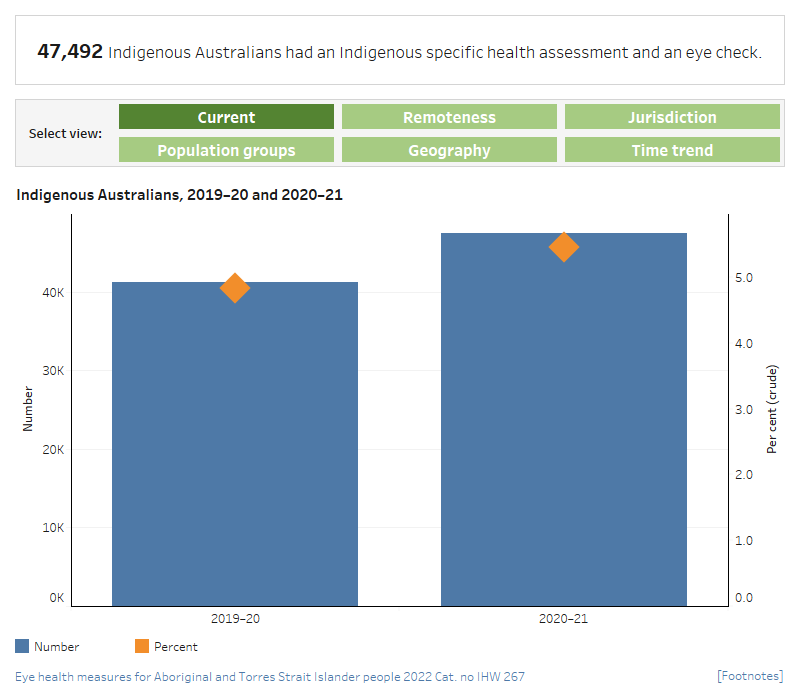Annual health assessments and initial eye examination by an optometrist
Measure 2.1.2: The number of Indigenous Australians who had an Indigenous health assessment (MBS item 715 or 228) including a health assessment provided via videoconference or teleconference (MBS item 92004, 92011, 92016, 92023), and who also had an initial eye examination by an optometrist.
Figure 2.1.2: Annual health assessments and initial eye examination by an optometrist
There are 7 separate charts for this measure, showing MBS health assessments and eye examinations, for Indigenous Australians by various characteristics.
Number and proportion of Indigenous Australians that had an Indigenous health assessment and an eye check by an optometrist, 2019-20 and 2020-21
This dual axis combined vertical bar chart and scatter plot displays the number and proportion of MBS health assessments in 2019–20 and 2020–21. The chart shows that 5.5% of Indigenous Australians (or 47,492 people) had an Indigenous-specific MBS health assessment and an eye check by an optometrist in 2020–21. This is an increase of 6,252 assessments and eye checks from 2019–20.
Proportion of Indigenous Australians that had an Indigenous health assessment and an eye check by an optometrist by remoteness, 2020-21
This vertical bar chart compares the proportion of MBS health assessments and eye examinations in 2020–21, by remoteness category of geographic location. The chart shows that the proportion of MBS 715 health assessments and eye examinations was highest in Outer regional areas (6.3%). The proportion was lowest in Very remote areas (3.9%).
Proportion of Indigenous Australians that had an Indigenous health assessment and an eye check by an optometrist by jurisdiction, 2020-21
This vertical bar chart compares the proportion of MBS health assessments and eye examinations in 2020–21, by state and territory. The chart shows that the proportion of MBS health assessments and eye examinations was highest in Queensland (6.9%) and New South Wales (5.8%) and was lowest in Western Australia (3.4%), Victoria and the Australian Capital Territory (both 3.5%).
Proportion of Indigenous Australians that had an Indigenous health assessment and an eye check by an optometrist by age and sex, 2020-21-Indigenous population (denominator)
This grouped vertical bar chart compares the proportion of MBS health assessments and eye examinations in 2020–21, by age and sex. The chart shows that the number and proportion of MBS health assessments and eye examinations were very similar for Indigenous males and females aged 0–14— 2.6% and 2.8%, respectively. For all other age groups, health assessments and eye examinations for Indigenous females outnumbered those for Indigenous males.
Proportion of Indigenous Australians that had an Indigenous health assessment and an eye check by an optometrist by age and sex, 2020-21-number of health assessments (denominator)
This grouped vertical bar chart compares the proportion of MBS health assessments and eye examinations in 2020–21, by age and sex. The chart shows that the proportion of MBS health assessments and eye examinations for Indigenous females outnumbered those for Indigenous males for all age groups except for those aged 75 and over where the proportion of assessments and eye examinations for Indigenous males outnumbered those for Indigenous females (55% and 52%, respectively).
Proportion of Indigenous Australians that had an Indigenous health assessment and an eye check by an optometrist by Primary Health Network (PHN), 2020-21
This horizontal bar chart shows the proportion of MBS health assessments and eye examinations in 2020–21, by PHN. The chart shows that the PHNs with the lowest proportion of health assessments were Eastern Melbourne (1.8%) and Perth North (3.3%), while those with the highest rates were Brisbane North (both 8.8%) and Brisbane South (8.1%).
Proportion of Indigenous Australians that had an Indigenous health assessment and an eye check by an optometrist by age 2010-11 to 2020-21
This line graph shows changes in the proportion of MBS health assessments and eye examinations, from 2010–11 to 2020–21, by age group. The chart shows that, between 2010–11 and 2020–21, the age-standardised proportion of MBS health assessments and eye examinations increased over time. This increase occurred across all age groups but was highest for those aged 65–74 and 75 and over (from around 3.8% to around 20% for both groups).

- In 2020–21, over one in twenty (47,492 or 5.5%) of Indigenous Australians had an Indigenous-specific health assessment and an initial eye examination by an optometrist.
- The age-standardised proportion of Indigenous Australians who had a health assessment and an initial eye examination by an optometrist increased from around 1% in 2010–11 to over 7% in 2018-19 before declining slightly in for the under 15 age group and 27% for the 15–54 age group in 2018–19, before declining slightly in 2019–20 (6.5%) and increasing in 2020–21(7.3%)
- In 2020–21, health assessments for Indigenous females outnumbered those for Indigenous males across all age groups, especially for age group 45–54 and 65–74.


